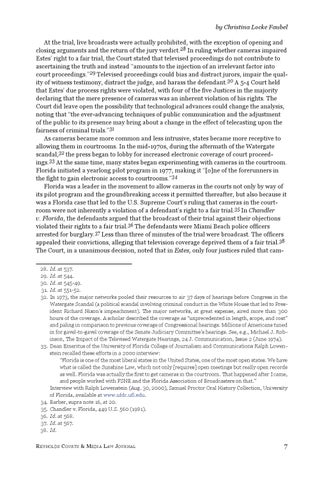by Christina Locke Faubel
At the trial, live broadcasts were actually prohibited, with the exception of opening and closing arguments and the return of the jury verdict.28 In ruling whether cameras impaired Estes’ right to a fair trial, the Court stated that televised proceedings do not contribute to ascertaining the truth and instead “amounts to the injection of an irrelevant factor into court proceedings.”29 Televised proceedings could bias and distract jurors, impair the quality of witness testimony, distract the judge, and harass the defendant.30 A 5-4 Court held that Estes’ due process rights were violated, with four of the five Justices in the majority declaring that the mere presence of cameras was an inherent violation of his rights. The Court did leave open the possibility that technological advances could change the analysis, noting that “the ever-advancing techniques of public communication and the adjustment of the public to its presence may bring about a change in the effect of telecasting upon the fairness of criminal trials.”31 As cameras became more common and less intrusive, states became more receptive to allowing them in courtrooms. In the mid-1970s, during the aftermath of the Watergate scandal,32 the press began to lobby for increased electronic coverage of court proceedings.33 At the same time, many states began experimenting with cameras in the courtroom. Florida initiated a yearlong pilot program in 1977, making it “[o]ne of the forerunners in the fight to gain electronic access to courtrooms.”34 Florida was a leader in the movement to allow cameras in the courts not only by way of its pilot program and the groundbreaking access it permitted thereafter, but also because it was a Florida case that led to the U.S. Supreme Court’s ruling that cameras in the courtroom were not inherently a violation of a defendant’s right to a fair trial.35 In Chandler v. Florida, the defendants argued that the broadcast of their trial against their objections violated their rights to a fair trial.36 The defendants were Miami Beach police officers arrested for burglary.37 Less than three of minutes of the trial were broadcast. The officers appealed their convictions, alleging that television coverage deprived them of a fair trial.38 The Court, in a unanimous decision, noted that in Estes, only four justices ruled that cam 28. Id. at 537. 29. Id. at 544. 30. Id. at 545-49. 31. Id. at 551-52. 32. In 1973, the major networks pooled their resources to air 37 days of hearings before Congress in the Watergate Scandal (a political scandal involving criminal conduct in the White House that led to President Richard Nixon’s impeachment). The major networks, at great expense, aired more than 300 hours of the coverage. A scholar described the coverage as “unprecedented in length, scope, and cost” and paling in comparison to previous coverage of Congressional hearings. Millions of Americans tuned in for gavel-to-gavel coverage of the Senate Judiciary Committee’s hearings. See, e.g., Michael J. Robinson, The Impact of the Televised Watergate Hearings, 24 J. Communication, Issue 2 (June 1974). 33. Dean Emeritus of the University of Florida College of Journalism and Communications Ralph Lowenstein recalled these efforts in a 2000 interview: “Florida is one of the most liberal states in the United States, one of the most open states. We have what is called the Sunshine Law, which not only [requires] open meetings but really open records as well. Florida was actually the first to get cameras in the courtroom. That happened after I came, and people worked with FSNE and the Florida Association of Broadcasters on that.” Interview with Ralph Lowenstein (Aug. 30, 2000), Samuel Proctor Oral History Collection, University of Florida, available at www.ufdc.ufl.edu. 34. Barber, supra note 16, at 20. 35. Chandler v. Florida, 449 U.S. 560 (1981). 36. Id. at 568. 37. Id. at 567. 38. Id.
R ey nolds C ourts & M edia L aw Jour nal
7
